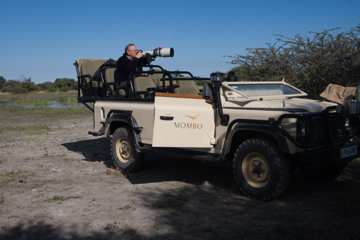Recommended by Distinctive Journeys
Going to Africa on safari is a trip of a lifetime. It is thrilling to be within telephoto range and sometimes closer of the most exciting animals on the planet.
A question always asked is what photo equipment should I take. We all have a variety of equipment we can take on safari. Because weight restrictions are difficult for photographers, careful selection of equipment is necessary.
First we recommend taking two cameras.
 This allows you to work with two lenses at the same time. Often you will find the wildlife situation changing quickly and you want to be ready before the action is over. Most importantly is if a camera should break down your photo trip will not be ruined after flying halfway around the world. You have a backup. If you don’t have two bodies it is a good idea to rent one.
This allows you to work with two lenses at the same time. Often you will find the wildlife situation changing quickly and you want to be ready before the action is over. Most importantly is if a camera should break down your photo trip will not be ruined after flying halfway around the world. You have a backup. If you don’t have two bodies it is a good idea to rent one.
If you have a 500mm with a 1.4, 1.7 or the 2x extenders your good shots will turn into awesome shots. There are many situations where you will appreciate the extra length. It takes up weight and is bulky, but the rewards will be worth it.
You will get great shots with a Canon 100-400mm or Nikon equivalent. In fact this lens will be your workhorse using approximately 70% of the time and mostly handheld.
We recommend taking a wide-angle lens to capture landscapes and dramatic skies. For this using a 70-105mm as an example or a 70-200mm, however you won’t be able to take everything because of weight.
Bring more flash cards than you think you will need. There are many to chose from. Sixteen gigs on up will be the best. Bring an external hard drive or two to download your mages on safari plus if you have enough cards you can use those as a backup also.
For South Africa you will want to purchase a Manfrotto Super Clamp if you don’t have one. This clamps on the railing of the seat as below and provides a solid foundation for long lenses. A tripod will not work in the vehicle. A monopod can be useful, but not as steady as a clamp.
East Africa
In East Africa, where most of the photography is done from vans, below, you will need a beanbag. This is what everybody uses in lieu of a tripod.
Weight & Luggage Restrictions for all light aircraft transfers.
Please note that there are specific limits applicable when traveling with the services of charters on a seat or circuit rate basis.
Luggage, including camera equipment and hand luggage, is restricted per person traveling on seat rates, as follows:
• 33lbs in Malawi
• 44lbs. in Botswana, Namibia, Zambia
and Zimbabwe
• 44lbs in South Africa
 Only soft bags will be accepted – no wheels, frames, or rigid structures can be transported, as they physically cannot fit into the aircraft.
Only soft bags will be accepted – no wheels, frames, or rigid structures can be transported, as they physically cannot fit into the aircraft.
The maximum dimensions of the soft bags, which can be accommodated, are as follows: 10 inches wide x 12 inches high and 24 inches long.
A collapsible-wheeled luggage frame/trolley [separate to the bag] is allowed, as long as basic dimensions are similar to that of the bag.
You may want to take a photo vest to alleviate some of the weight issue. You could put small lenses, battery chargers and other small items into the pockets. This will count as body weight and not luggage weight if you don’t over do it by cramming to much into the vest.
There are laundry services in most camps so you can cut way down on clothes to help with weight.
This is a trip of a lifetime.
“You can leave Africa, but it never leaves you”
“I missed Africa already, and I hadn’t even left yet”
– Ernest Hemingway
